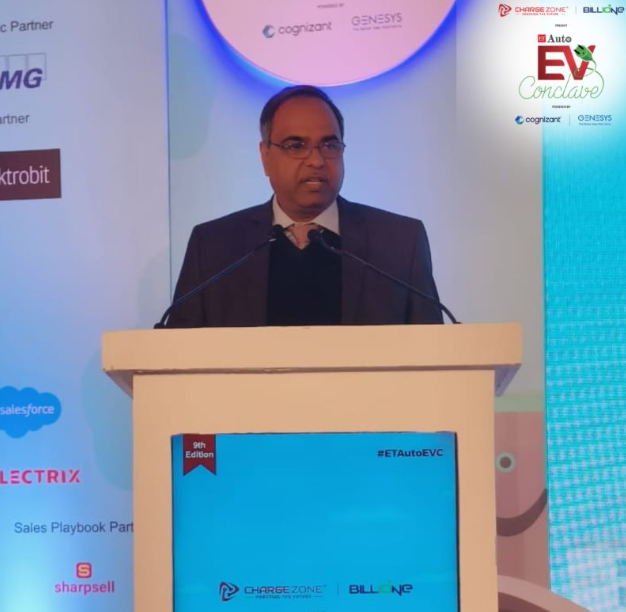“,”elements”:[]}],”thumb_big”:”https://etimg.etb2bimg.com/thumb/msid-116681426,imgsize-409694,width-1200,height=765,overlay-etauto/industry/need-concerted-efforts-from-across-ecosystem-to-drive-ev-adoption-says-siam-president.jpg”,”thumb_small”:”https://etimg.etb2bimg.com/thumb/img-size-409694/116681426.cms?width=150&height=112″,”time”:”2024-12-26 16:01:21″,”is_live”:false,”prime_id”:0,”highlights”:[],”highlights_html”:””,”also_read_available”:false,”body”:”
 Shailesh Chandra, President, SIAM
Shailesh Chandra, President, SIAM“>
“Reducing emissions from the auto industry cannot be achieved through individual efforts alone. It will require concerted efforts from across the ecosystem, with synergies from vehicle manufacturers, suppliers, policy makers, and charging infrastructure players to drive both the demand and supply of green mobility for customers,” Chandra said.
He is also the Managing Director of Tata Motors Passenger Vehicles and Tata Passenger Electric Mobility.
What needs to be done?
According to a recent report by FICCI-Yes Bank, EV penetration in India has grown at an annual rate of approximately 200 basis points (bps) between FY21 and FY24, but needs to double to 380 bps per year to achieve the national target of 30% EV adoption by 2030. It emphasised that the current pace of growth is insufficient to meet the ambitious target.
At present, EV adoption is being led by the two- and three-wheeler segments. Chandra stated that the evolution of EVs in the country has been more than just a technological shift. To enable this development further, India needs a robust and consistent policy framework with alignment across central and state governments.
“Government support will be required across segments until EVs are able to reach self-sustaining volume and penetrate individual segments,” he said.
To fast track the EV adoption rate, Chandra highlighted that OEMs must invest in and develop more products to meet diverse customer needs, while also working towards achieving price parity between EVs and ICE vehicles. Further, localisation of battery manufacturing will be crucial for ensuring a self-sufficient supply ecosystem
He also emphasised the need to invest in re-skilling the workforce, building on existing technical and human resource capabilities, and equipping employees with emerging EV-related skills to address skill gaps.
Charging Infrastructure
Investments by charge point operators (CPOs) and oil marketing companies (OMCs) to expand the charging infrastructure has shown a promising growth trajectory. However, a lot still needs to be done.
Chandra flagged three key areas that need to be taken care of. First, a robust and strategically planned public charging network at high-traffic locations is essential to provide convenience for long-distance travel.
Second, home charging– which currently accounts for around 95% of customer charging– should be supported through individual or community-level chargers. Lastly, the growing charging infrastructure must be reliable, with proper maintenance and accessibility, to build customer confidence and ensure they aren’t stranded on the road.
“,”next_sibling”:[{“msid”:116680255,”title”:”Stage IV GRAP revoked as Delhi’s air quality improves; Stage I-III measures intensified”,”entity_type”:”ARTICLE”,”link”:”/news/industry/stage-iv-grap-revoked-as-delhis-air-quality-improves-stage-i-iii-measures-intensified/116680255″,”link_next_mobile”:”/news/industry/stage-iv-grap-revoked-as-delhis-air-quality-improves-stage-i-iii-measures-intensified/116680255?next=1″,”category_name”:null,”category_name_seo”:”industry”}],”related_content”:[],”seoschemas”:false,”social_share”:{“fb”:”/news/industry/need-concerted-efforts-from-across-ecosystem-to-drive-ev-adoption-says-siam-president/116681426?utm_source=facebook&utm_medium={{DEVICE_TYPE}}”,”x”:”/news/industry/need-concerted-efforts-from-across-ecosystem-to-drive-ev-adoption-says-siam-president/116681426?utm_source=twitter&utm_medium={{DEVICE_TYPE}}”,”whatsapp”:”/news/industry/need-concerted-efforts-from-across-ecosystem-to-drive-ev-adoption-says-siam-president/116681426?utm_source=wapp&utm_medium={{DEVICE_TYPE}}”,”linkdin”:”/news/industry/need-concerted-efforts-from-across-ecosystem-to-drive-ev-adoption-says-siam-president/116681426?utm_source=linkedin&utm_medium={{DEVICE_TYPE}}”,”telegram”:”/news/industry/need-concerted-efforts-from-across-ecosystem-to-drive-ev-adoption-says-siam-president/116681426?utm_source=telegram&utm_medium={{DEVICE_TYPE}}”,”copy”:”/news/industry/need-concerted-efforts-from-across-ecosystem-to-drive-ev-adoption-says-siam-president/116681426?utm_source=copy&utm_medium={{DEVICE_TYPE}}”},”cat_msid”:25384693,”cat_sub_msid”:false,”msid”:116681426,”entity_type”:”ARTICLE”,”title”:”Need concerted efforts from across ecosystem to drive EV adoption, says SIAM President”,”synopsis”:”u201cReducing emissions from the auto industry cannot be achieved through individual efforts alone. It will require concerted efforts from across the ecosystem, with synergies from vehicle manufacturers, suppliers, policy makers, and charging infrastructure players to drive both the demand and supply of green mobility for customers,u201d Shailesh Chandra, President of auto industry body SIAM said. “,”titleseo”:”industry/need-concerted-efforts-from-across-ecosystem-to-drive-ev-adoption-says-siam-president”,”status”:”ACTIVE”,”authors”:[{“author_name”:”Shubhangi Bhatia”,”author_link”:”/author/479253327/shubhangi-bhatia”,”author_api_link”:”/author/479253327″,”author_image”:”https://etimg.etb2bimg.com/authorthumb/479253327.cms?width=250&height=250&imgsize=93050″,”author_additional”:{“thumbsize”:true,”msid”:479253327,”author_name”:”Shubhangi Bhatia”,”author_seo_name”:”shubhangi-bhatia”,”designation”:”Principal Correspondent”,”agency”:false}}],”analytics”:{“comments”:0,”views”:239,”shares”:0,”engagementtimems”:1167000},”Alttitle”:{“minfo”:””},”artag”:”ETAuto”,”artdate”:”2024-12-26 16:01:21″,”lastupd”:”2024-12-27 11:54:29″,”breadcrumbTags”:[“Shailesh Chandra SIAM”,”EV adoption”,”electrical vehicles”,”SIAM President”,”zero-emission vehicles”,”FICCI-Yes Bank”,”workforce re-skilling EV”,”SIAM”,”ev and future mobility”,”EV Adoption in India”],”secinfo”:{“seolocation”:”industry/need-concerted-efforts-from-across-ecosystem-to-drive-ev-adoption-says-siam-president”}}” data-authors=”[” shubhangi data-author-list=”Shubhangi Bhatia” data-category-name=”Industry” data-category_id=”23″ data-cat_msid=”25384693″ data-date=”2024-12-26″ data-index=”article_1″ data-keywords=”Shailesh Chandra SIAM, EV adoption, electrical vehicles, SIAM President, zero-emission vehicles, FICCI-Yes Bank, workforce re-skilling EV, SIAM, ev and future mobility, EV Adoption in India” data-type=”news”>
“Reducing emissions from the auto industry cannot be achieved through individual efforts alone. It will require concerted efforts from across the ecosystem, with synergies from vehicle manufacturers, suppliers, policy makers, and charging infrastructure players to drive both the demand and supply of green mobility for customers,” Shailesh Chandra, President of auto industry body SIAM said.
Read by: 100 Industry Professionals
Read by 100 Industry Professionals
 Shailesh Chandra, President, SIAM
Shailesh Chandra, President, SIAM“>
He is also the Managing Director of Tata Motors Passenger Vehicles and Tata Passenger Electric Mobility.
What needs to be done?
According to a recent report by FICCI-Yes Bank, EV penetration in India has grown at an annual rate of approximately 200 basis points (bps) between FY21 and FY24, but needs to double to 380 bps per year to achieve the national target of 30% EV adoption by 2030. It emphasised that the current pace of growth is insufficient to meet the ambitious target.At present, EV adoption is being led by the two- and three-wheeler segments. Chandra stated that the evolution of EVs in the country has been more than just a technological shift. To enable this development further, India needs a robust and consistent policy framework with alignment across central and state governments.
“Government support will be required across segments until EVs are able to reach self-sustaining volume and penetrate individual segments,” he said.
To fast track the EV adoption rate, Chandra highlighted that OEMs must invest in and develop more products to meet diverse customer needs, while also working towards achieving price parity between EVs and ICE vehicles. Further, localisation of battery manufacturing will be crucial for ensuring a self-sufficient supply ecosystemHe also emphasised the need to invest in re-skilling the workforce, building on existing technical and human resource capabilities, and equipping employees with emerging EV-related skills to address skill gaps.Charging Infrastructure
Investments by charge point operators (CPOs) and oil marketing companies (OMCs) to expand the charging infrastructure has shown a promising growth trajectory. However, a lot still needs to be done.
Chandra flagged three key areas that need to be taken care of. First, a robust and strategically planned public charging network at high-traffic locations is essential to provide convenience for long-distance travel.
Second, home charging– which currently accounts for around 95% of customer charging– should be supported through individual or community-level chargers. Lastly, the growing charging infrastructure must be reliable, with proper maintenance and accessibility, to build customer confidence and ensure they aren’t stranded on the road.
Join the community of 2M+ industry professionals
Subscribe to our newsletter to get latest insights & analysis.




